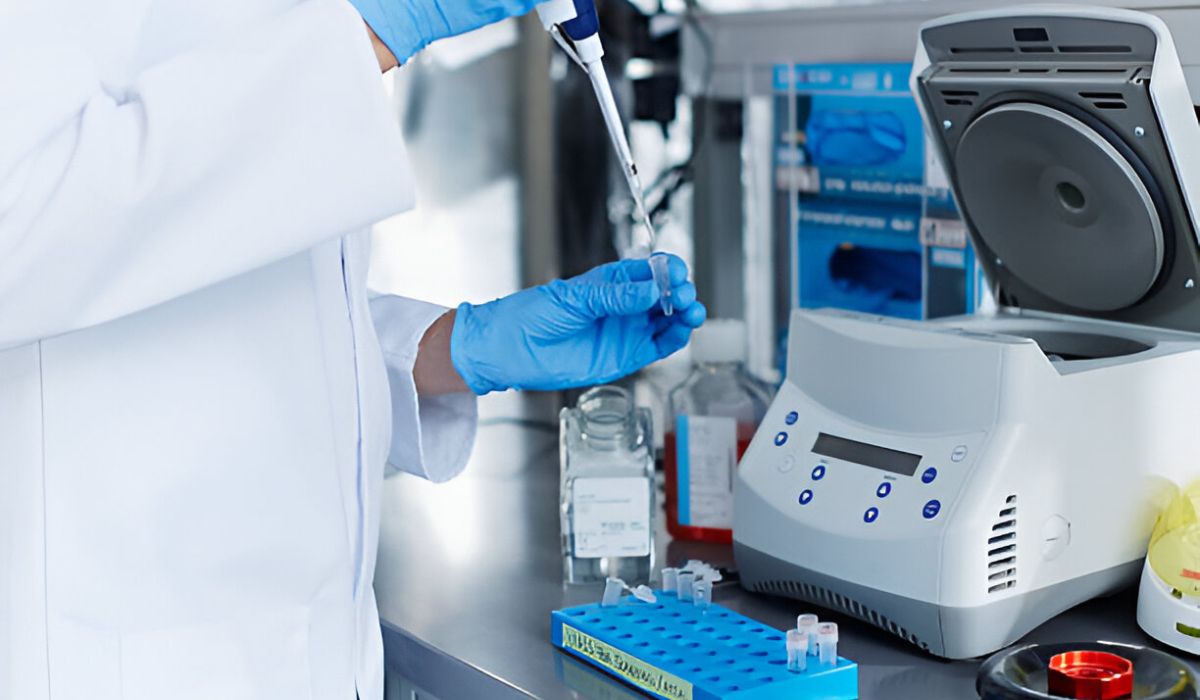Laboratory centrifuges are essential tools used to separate materials in various scientific fields. By spinning samples at high speeds, they create a force that separates substances based on their density. Whether you’re in a biology lab or conducting research, understanding how these machines work is crucial for effective experiments.
You might wonder how a small device can perform such complex tasks. The operation of a centrifuge involves key components like the rotor and motor, each playing a unique role in achieving efficient separation. Knowing the different types of centrifuges and their specific applications can help you choose the right one for your needs.
As you read on, you’ll discover the fundamental principles of centrifugation, the types of lab centrifuges available, and how to operate them safely and effectively, enhancing your understanding and skills in the lab.
Key Takeaways
- Centrifuges use high-speed spinning to separate substances by density.
- Different types of centrifuges serve various scientific purposes.
- Understanding key components improves safety and effectiveness during operation.
Fundamental Principles of Centrifugation
Centrifugation relies on specific physical principles to separate substances effectively. The process involves understanding the effects of rotational motion and the concept of density differences among particles. This section explains these fundamental principles to help you grasp how centrifuges function.

Rotational Motion and Centrifugal Force
When a centrifuge spins, it creates rotational motion. This motion generates centrifugal force, which pushes particles outward from the center of rotation. The force acts differently on particles based on their mass and density. Heavier particles experience a greater force, causing them to move more rapidly to the outer edges of the container.
The speed at which the centrifuge operates is crucial. Higher speeds result in stronger centrifugal forces, enhancing the separation process. Typically measured in revolutions per minute (RPM), these speeds can vary based on the application.
Understanding this motion helps you predict how particles will separate within the centrifuge. As a result, proper settings are essential for achieving the desired outcomes in your experiments.
Density Gradient and Particle Separation
Centrifugation separates particles according to their density. When samples are placed in a centrifuge, different materials settle at various rates due to their density differences. Denser particles move toward the bottom of the container during the spinning process.
To optimize separation, a density gradient can be created within the tube. This is typically achieved using solutions with specific densities, allowing for a more precise separation of particles. For instance, in biological applications, gradients can help isolate cells based on their type or condition.
As the centrifuge spins, layers form within the sample, making it easier to collect specific fractions after centrifugation. This principle is critical in research and clinical laboratories where purity and accuracy are paramount.
Types of Lab Centrifuges
Lab centrifuges come in various designs, each suited for specific tasks. Understanding these types will help you choose the right one for your experiments.
Microcentrifuges
Microcentrifuges are compact and designed for small sample volumes, typically ranging from 0.5 to 2.0 mL. They spin samples at high speeds, usually between 10,000 and 15,000 revolutions per minute (RPM).
These devices are common in molecular biology labs for tasks like DNA and RNA extraction. They are known for their efficiency in separating cellular components such as proteins or nucleic acids.
Microcentrifuges often have a fixed-angle rotor, simply meaning that the sample tubes are held at a constant angle while spinning. This design maximizes separation efficiency. Some models include advanced features like temperature control.
Ultracentrifuges
Ultracentrifuges are high-speed centrifuges capable of achieving speeds above 20,000 RPM. They are used for more complex separations, such as isolating viruses, organelles, or macromolecules.
These centrifuges require special rotors and sample tubes due to the extreme forces generated during operation. The maximum centrifugal force can exceed 100,000 x g, allowing for precise separations.
Ultracentrifuges can be floor-standing or benchtop units. They may offer temperature control to prevent sample degradation during long runs. This is crucial for biological samples where temperature fluctuations can cause harm.
Refrigerated Centrifuges
Refrigerated centrifuges are essential when temperature-sensitive samples are involved. These centrifuges maintain a low temperature during operation, usually between 0°C and 4°C.
Cooling prevents chemical reactions and degradation that might occur at higher temperatures. This is particularly important in separating biological samples where enzymes could be activated or proteins denatured.
You can find refrigerated centrifuges in various sizes, from benchtop models to larger floor-standing units. Many include programmable settings, allowing you to set specific speeds and cooling temperatures for different protocols.
Key Components and Their Functions
Lab centrifuges consist of several crucial components that work together to achieve effective separation in various samples. Understanding these parts will help you appreciate their roles and importance in centrifugation processes.
Rotor Design
The rotor is a central part of any centrifuge. It holds the sample tubes and rotates them at high speeds. There are various rotor designs, such as fixed-angle and swing-out rotors.
- Fixed-Angle Rotors keep tubes at a specific angle during spinning. This design is ideal for pelleting cells or separating blood components.
- Swing-Out Rotors allow the tubes to swing out during operation, providing a horizontal position. This helps achieve better separation of layers, especially in applications like blood fractionation.
Choosing the right rotor impacts the efficiency of the separation process, making rotor design a critical factor in centrifuge performance.
Drive Shaft and Motor
The drive shaft connects the rotor to the centrifuge motor. It transmits the power needed for high-speed rotation. The motor type can influence the centrifuge’s capability:
- Brushless DC Motors offer high efficiency and low maintenance, making them suitable for most laboratory applications.
- Induction Motors are often used in older models and are reliable but can require more upkeep.
The speed and stability of the motor are essential for consistent results. Ensuring that the drive shaft and motor are well-maintained is crucial for safety and effectiveness.
Temperature Control Systems
Temperature control systems are vital in preventing heat buildup during centrifugation. They ensure that samples remain stable and free from damage.
- Refrigerated Centrifuges have built-in cooling systems. These are important for sensitive samples like proteins or enzymes that may degrade under high temperatures.
- Heat-Resistant Systems may be sufficient for more robust samples, but you’ll need to monitor temperatures closely.
Maintaining the appropriate temperature helps preserve the integrity of your samples and enhances the accuracy of your results.
Operating a Centrifuge
Knowing how to operate a centrifuge properly is vital for safety and accuracy in your lab work. The process includes loading and balancing samples carefully and setting the appropriate speed and time for your specific application.
Loading and Balancing
Before using the centrifuge, ensure you load it correctly. Always balance the rotor by placing samples opposite each other. If you have one tube, place another tube of equal weight directly across from it. This balance prevents equipment damage and ensures accurate results.
Use identical containers whenever possible. If your samples vary in volume, fill tubes to make them equal.
Important Tips:
- Always check the rotor type to ensure proper fit.
- Make sure the lids on all tubes are secure.
- Inspect the rotor for wear or damage before loading.
Setting Speed and Time
Setting the correct speed and time is crucial for achieving optimal results. Each type of sample requires specific conditions, so always refer to established protocols.
Most centrifuges allow you to set speed in revolutions per minute (RPM) or relative centrifugal force (RCF). If you’re unsure, RCF is often more useful for comparisons.
Steps to Set Speed and Time:
- Turn on the centrifuge and set the desired RPM or RCF on the control panel.
- Input the time required for your particular procedure.
Frequently Asked Questions
This section addresses common questions about laboratory centrifuges. You will find specific information about their working principles, operation, and uses in various settings.
What is the working principle of a laboratory centrifuge?
A laboratory centrifuge separates components of a mixture based on density. It spins samples at high speeds, creating a force that causes denser materials to move to the bottom of the container.
How does a blood centrifuge operate?
A blood centrifuge operates by spinning blood samples at a high speed. This process separates blood into its main components: red blood cells, white blood cells, plasma, and platelets, allowing for easier analysis.
What are the physics involved in the operation of a centrifuge?
The physics of a centrifuge involves centrifugal force and gravitational force. As the centrifuge spins, centrifugal force pushes particles outward, while gravity helps keep the denser materials at the bottom.
What are the primary uses of a centrifuge in laboratory settings?
Centrifuges are primarily used for cell collection, organelle purification, and separation of biological samples. They also play a significant role in research, clinical testing, and quality control in laboratories.
In what ways are centrifuges utilized within medical laboratories?
In medical laboratories, centrifuges are essential for processing blood samples, urine, and other fluids. They help prepare samples for testing and analysis, improving the efficiency of diagnoses and treatments.
What scientific concepts underlie the process of centrifugation?
Centrifugation is based on several scientific concepts, including sedimentation, density, and relative centrifugal force (RCF). These principles guide how and why specific components separate during the centrifuge’s operation.
